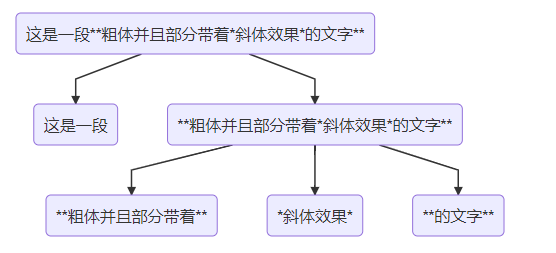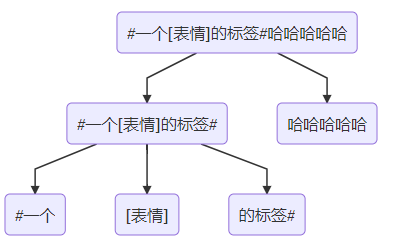SuperText富文本设计方案
Flutter中要实现富文本,需要使用RichText或者Text.rich方法,通过拆分成List来实现,第一感觉上好像还行,但实际使用了才知道,有一个很大的问题就是对于复杂的富文本效果,无法准确拆分出具有实际效果的spans。因此想设计一个具有多种富文本效果,同时便于使用的富文本控件SuperText。
RichText原理
Flutter中的InlineSpan其实是Tree的结构。例如一段md样式的文字:
其实就是被拆分了3段TextSpan,然后下面绘制的时候,就会使用ParagraphBuilder分别访问这3个节点,3个节点分别往ParagraphBuilder中填充对应的文字以及样式。
那么是否这个树的深度一定只有2层?
这个未必,如果一开始就解析拆分出所有的富文本效果,那么可能就只有2层,但实际上就算是多层,也是没有问题的,例如:
这是一段粗体并且部分带着斜体效果的文字
可以拆分成如下:
需要注意的是TextSpan中有两个参数,一个是text,一个是children。这两个参数是同时生效的, 先用TextSpan中的style和structstyle显示text,然后再接着显示children。例如:
Text.rich(
TextSpan(
text: '123456',
children: [
TextSpan(
text: 'abcdefg',
style: TextStyle(color: Colors.blue),
),
]
),
)
最终显示的效果是123456abcdefg,其中abcdefg是蓝色的。
方案设计
了解了富文本的原理后,封装控件需要实现的目标就确定了,那就是
自动将文本text,转换成inlineSpan组成的树
然后丢给Text控件去显示。
那么如何去实现这个转化的过程?我的想法是依次遍历节点,然后衍生出新的节点,最终由叶子节点组成最终的显示效果。
我们以包含自定义表情和##标签的效果为例子。
#一个[表情]的标签#哈哈哈哈哈
首先初始状态只有文本text的情况下,可以认为是一个树的根节点,里面存在文本text。我们可以先把标签解析出来,那么就能从这个根节点,拆分出2个节点:
然后再将两个叶子节点解析自定义表情:
最终得到4个叶子节点,最终生成的InlineSpan,应该如下:
TextSpan(
children: [
TextSpan(
style: TextStyle(color: Colors.blue),
children: [
TextSpan(
text: '#一个',
),
WidgetSpan(
child: Image.asset(),
),
TextSpan(
text: '的标签#',
),
],
),
TextSpan(
text: '哈哈哈哈哈',
style: TextStyle(color: Colors.black),
),
],
),
上述过程,涉及到三点:1. 遍历;2. 解析拆分;3. 生成节点。等到了最终所有叶子结点都无法再被拆分出新节点时,这颗InlineSpan树就是最终的解析结果。
解析
如何进行解析。像Emoji表情或者http链接那种,一般都是使用正则便能识别出来,而更加简单的变颜色、改字体大小这种,在Android上都是直接通过设置起始位置和结束位置来标明范围的,我们也可以使用这种简单好理解的方式来实现,所以解析的时候,需要能够拿到待解析内容在原始文本中的位置。例如原文“一个需要放大的字”,已经被其他解析器分成了两段“一个需要”和“放大的字”,在斜体解析器解析“放大的字”的时候,需要知道原文第5到第6个字需要变成斜体,在把这5->6转变成相对于“放大的字”这一段而言的第1到第2个字。
代码设计
方案理解了之后,就开始简单的框架编写。
节点定义
按照树结构,定义一个Node
class TextNode {
///该节点文本
String text;
TextStyle style;
late InlineSpan span;
///该节点文本,在原始文本中的开始位置。include
int startPosInOri;
///该节点文本,在原始文本中的结束位置。include
int endPosInOri;
List? subNodes;
TextNode(this.text, this.style,
{required this.startPosInOri, required this.endPosInOri});
}
Span构造器定义
abstract class BaseSpanBuilder {
bool isSupport(TextNode node);
///
/// 解析生成子节点
///
List parse(TextNode node);
}
SuperText定义
先作为一个简单版的Text控件,接收text、TextStyle和构造器列表即可。
class SuperText extends StatefulWidget {
final String text;
final TextStyle style;
final List? spanBuilders;
const SuperText(
this.text, {
Key? key,
required this.style,
this.spanBuilders,
}) : super(key: key);
@override
State createState() {
return _SuperTextState();
}
}
对应的build()方法:
late InlineSpan _textSpan;
@override
Widget build(BuildContext context) {
return Text.rich(
_textSpan,
style: widget.style,
);
}
之后需要做的事就是把传入的text解析成_textSpan即可。
InlineSpan _buildSpans() {
if (widget.spanBuilders?.isEmpty ?? true) {
return TextSpan(text: widget.text, style: widget.style);
} else {
//准备根节点
TextNode rootNode = TextNode(widget.text, widget.style,
startPosInOri: 0, endPosInOri: widget.text.length - 1);
rootNode.span = TextSpan(text: widget.text, style: widget.style);
//开始生成子节点
_generateNodes(rootNode, 0);
//深度优先遍历,生成最终的inlineSpan
List children = [];
dfs(rootNode, children);
return TextSpan(children: children, style: widget.style);
}
}
void _generateNodes(TextNode node, int builderIndex) {
BaseSpanBuilder spanBuilder = widget.spanBuilders![builderIndex];
if (spanBuilder.isSupport(node)) {
List subNodes = spanBuilder.parse(node);
node.subNodes = subNodes.isEmpty ? null : subNodes;
if (builderIndex + 1 < widget.spanBuilders!.length) {
if (subNodes.isNotEmpty) {
//生成了子节点,那么把子节点抛给下个span构造器
for (TextNode n in subNodes) {
_generateNodes(n, builderIndex + 1);
}
} else {
//没有子节点,说明当前的span构造器不处理当前的节点内容,那么把当前的节点抛给下个span构造器
_generateNodes(node, builderIndex + 1);
}
}
}
}
///
/// 深度优先遍历,构建最终的List
///
void dfs(TextNode node, List children) {
if (node.subNodes?.isEmpty ?? true) {
children.add(node.span);
} else {
for (TextNode n in node.subNodes!) {
dfs(n, children);
}
}
}
实现逻辑基本就是方案设计中的想法。
可以修改TextStyle的Span构造器
舞台准备好了,那个要训练演员了。这里编写一个TextStyleSpanBuilder,用于接受TextStyle作为富文本样式:
class TextStyleSpanBuilder extends BaseSpanBuilder {
final int startPos;
final int endPos;
final Color? textColor;
final double? fontSize;
final FontWeight? fontWeight;
final Color? backgroundColor;
final TextDecoration? decoration;
final Color? decorationColor;
final TextDecorationStyle? decorationStyle;
final double? decorationThickness;
final String? fontFamily;
final double? height;
final List? shadows;
TextStyleSpanBuilder(
this.startPos,
this.endPos, {
this.textColor,
this.fontSize,
this.fontWeight,
this.backgroundColor,
this.decoration,
this.decorationColor,
this.decorationStyle,
this.decorationThickness,
this.fontFamily,
this.height,
this.shadows,
}) : assert(startPos >= 0 && startPos <= endPos);
@override
List parse(TextNode node) {
List result = [];
if (startPos > node.endPosInOri || endPos < node.startPosInOri) {
return result;
}
if (startPos >= node.startPosInOri) {
//富文本开始位置,在这段文字之内
if (startPos > node.startPosInOri) {
int endRelative = startPos - node.startPosInOri;
String subText = node.text.substring(0, endRelative);
TextNode subNode = TextNode(
subText,
node.style,
startPosInOri: node.startPosInOri,
endPosInOri: startPos - 1,
);
subNode.span = TextSpan(text: subNode.text, style: subNode.style);
result.add(subNode);
}
//富文本在这段文字的开始位置
int startRelative = startPos - node.startPosInOri;
int endRelative;
String subText;
TextStyle textStyle;
if (endPos <= node.endPosInOri) {
//结束位置在这段文字内
endRelative = startRelative + (endPos - startPos);
} else {
//结束位置,超出了这段文字。将开始到这段文字结束,都包含进富文本去
endRelative = node.endPosInOri - node.startPosInOri;
}
subText = node.text.substring(startRelative, endRelative + 1);
textStyle = copyStyle(node.style);
TextNode subNode = TextNode(
subText,
textStyle,
startPosInOri: node.startPosInOri + startRelative,
endPosInOri: node.startPosInOri + endRelative,
);
subNode.span = TextSpan(text: subNode.text, style: subNode.style);
result.add(subNode);
if (endPos < node.endPosInOri) {
//还有剩下的一段
startRelative = endPos - node.startPosInOri + 1;
endRelative = node.endPosInOri - node.startPosInOri;
subText = node.text.substring(startRelative, endRelative + 1);
TextNode subNode = TextNode(
subText,
node.style,
startPosInOri: endPos + 1,
endPosInOri: node.endPosInOri,
);
subNode.span = TextSpan(text: subNode.text, style: subNode.style);
result.add(subNode);
}
} else {
//富文本开始位置不在这段文字之内,那就检查富文本结尾的位置,是否在这段文字内
if (node.startPosInOri <= endPos) {
int startRelative = 0;
int endRelative;
String subText;
TextStyle textStyle;
if (endPos <= node.endPosInOri) {
//富文本结尾位置,在这段文字内
endRelative = endPos - node.startPosInOri;
} else {
//富文本结尾位置,超过了这段文字
endRelative = node.endPosInOri - node.startPosInOri;
}
subText = node.text.substring(startRelative, endRelative + 1);
textStyle = copyStyle(node.style);
TextNode subNode = TextNode(
subText,
textStyle,
startPosInOri: node.startPosInOri + startRelative,
endPosInOri: node.startPosInOri + endRelative,
);
subNode.span = TextSpan(text: subNode.text, style: subNode.style);
result.add(subNode);
if (endPos < node.endPosInOri) {
//还有剩下的一段
startRelative = endPos - node.startPosInOri + 1;
endRelative = node.endPosInOri - node.startPosInOri;
subText = node.text.substring(startRelative, endRelative + 1);
TextNode subNode = TextNode(
subText,
node.style,
startPosInOri: endPos + 1,
endPosInOri: node.endPosInOri,
);
subNode.span = TextSpan(text: subNode.text, style: subNode.style);
result.add(subNode);
}
}
}
return result;
}
TextStyle copyStyle(TextStyle style) {
return style.copyWith(
color: textColor,
fontSize: fontSize,
fontWeight: fontWeight,
backgroundColor: backgroundColor,
decoration: decoration,
decorationColor: decorationColor,
decorationStyle: decorationStyle,
decorationThickness: decorationThickness,
fontFamily: fontFamily,
height: height,
shadows: shadows,
);
}
@override
bool isSupport(TextNode node) {
return node.span is EmojiSpan || node.span is TextSpan;
}
}
parse方法在做的事,就是将一个TextNode拆分成多段的TextNode。
效果展示
SuperText(
'0123456789',
style: const TextStyle(color: Colors.red, fontSize: 16),
spanBuilders: [
TextStyleSpanBuilder(2, 6, textColor: Colors.blue),
TextStyleSpanBuilder(4, 7, fontSize: 40),
TextStyleSpanBuilder(6, 9, backgroundColor: Colors.green),
TextStyleSpanBuilder(1, 1, decoration: TextDecoration.underline),
],
)
效果如图:
这个用法,好像和原来的也没啥差别啊。其实不然,首先多个效果之间可以交叉重叠,另外这里展示的是基本的使用TextStyle实现的富文本效果。如果是那种需要依靠正则解析拆分后实现的富文本效果,例如自定义表情,只需要一个EmojiSpanBuilder()即可。
结语
按照这个方案,对于不同的富文本效果,只需要定制不同的spanBuilder就可以了,使用方法非常类似于Android的SpannableStringBuilder。
以上就是Flutter实现编写富文本Text的示例代码的详细内容,更多关于Flutter富文本的资料请关注脚本之家其它相关文章!




